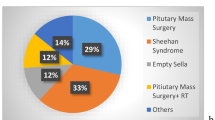Abstract
Dynamic testing of the hypothalamic pituitary system in familial hypogonadotropic hypogonadism has suggested the possibility of a central nervous disorder associated with variable pituitary secretory secretion. In order to investigate this issue further 7 patients of two families were studied. Male patients exhibited two types of FSH responses to LHRH administration. Two patients had a small response, and the other exhibited a normal response. The LH response was absent or small in both male and female patients. One month therapy with daily injections of LHRH did not improve pituitary responsiveness to a second LHRH test. Estrogen treatment given to females during one month had no improvement effect on another LHRH test. Estradiol benzoate produced a surge in both LH and FSH in half of patients tested which is surprising in the presence of a previous clomiphene negative response. Two of four women had elevated prolactin levels which increased defectuosly after metoclopramide administration which could suggest an abnormal hypothalamic status. On the basis of these results it seems that familial hypogonadotropism is originated by an abnormality at two levels, the anterior pituitary and the hypothalamus as well.
Similar content being viewed by others
References
Tagatz G., Fialkow P.J., Smith D., Spandoni L. Hypogonadotropic hypogonadism associated with anosmia in the female. N. Engl. J. Med. 283: 1326, 1970.
Bardin C.W., Ross G.T., Rifkind A.B., Cargille Ch.M., Lipsett M.B. Studies of the pituitary-Leydig cell axis in young men with hypogonadotropic hypogonadism and hyposmia: comparison with normal men, prepuberal boys, and hypopituitary patients. J. Clin. Invest. 48: 1046, 1969.
Biben R.L., Gordan G.S. Familial hypogonadotropic eunuchoidism. J. Clin. Endocrinol. Metab. 15: 931, 1955.
Matte R., D’Amour P., Faiman Ch., Winter J.S.D. Familial hypothalamic hypogonadotropic hypogonadism. Can. Med. Assoc. J. 110: 509, 1974.
Spitz I.M., Diamant Y., Rosen E., Bell J., Ben David M., Polishuk W., Rabinowitz D. Isolated gonadotropic deficiency. N. Engl. J. Med. 290: 10, 1974.
Yamaji T., Shimamoto K., Kosaka K., Isurigi K. Heterogeneity of prolactin and TSH response to TRH in hypogonadotropic hypogonadism. J. Clin. Endocrinol. Metab. 45: 319, 1977.
Zarate A., Kastin A.J., Soria J., Canales E.S., Schally A.V. Effect of synthetic luteinizing hormone-releasing hormone (LHRH) in two brothers with hypogonadotropic hypogonadism and anosmia. J. Clin. Endocrinol. Metab. 36: 612, 1973.
Borreman E., Wyman H., Rochefort J.G., Van Campenhout J. The responses to synthetic luteinizing hormone-releasing hormone in patients with primary selective pituitary deficiency in gonadotropins. Am. J. Obstet. Gynecol. 123: 580, 1975.
Forsbach G., Soria J., Canales E.S., Guzmán V., Cabezas A., Zarate A. Gonadotropic responsiveness to clomiphene LHRH, estradiol and bromocriptine in galactorrheic women. Obstet. Gynecol. 50: 134, 1977.
Midgley A.R. Radioimmunoassy: A method for human chorionic gonadotropin and human luteinizing hormone. Endocrinology 79: 10, 1966.
Midgley A.R. Radioimmunoassay for human follicle stimulating hormone. J. Clin. Endocrinol. Metab. 27: 295, 1967.
Odell W.D., Rayford P.L, Ross G.T. Simplified partially automated method for radioimmu- noassay of human thyroid growth, luteinizing and follicle stimulating hormone. J. Lab. Clin. Med. 70: 973, 1967.
Hwang P., Guyda H. Friesen H. A radioimmunoassay for human prolactin. Proc. Natl. Acad. Sci. USA 68: 1902, 1971.
Soria J., Ayala A., Forsbach G., Arcovedo F., Canales E.S., Karchmer S., Zàrate A. Anterior pituitary during the early neonatal period. Arch. Invest. Med. (Mex) 8: 24, 1977.
Healy D.L, Pepperell R.J., Stockdale J., Bremer W.J. Pituitary autonomy in hyperprolactinemic secondary amenorrhea: Results of hypothalamic-pituitary testing. J. Clin. Endocrinol. Metab. 44: 809, 1977.
Author information
Authors and Affiliations
Additional information
Supported by IMSS-FORD Foundation.
Rights and permissions
About this article
Cite this article
Fernández-Lazala, R., Cabezas, A., Fonseca, M.E. et al. Heterogeneous pituitary secretion in familial hypogonadotropic hypogonadism. J Endocrinol Invest 2, 291–295 (1979). https://doi.org/10.1007/BF03350419
Received:
Accepted:
Published:
Issue Date:
DOI: https://doi.org/10.1007/BF03350419



